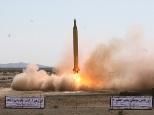 Iran’s military continues to improve the accuracy and killing power of its long- and short-range ballistic missiles, including designing a weapon to target vessels, according to a Pentagon report to Congress.
Iran’s military continues to improve the accuracy and killing power of its long- and short-range ballistic missiles, including designing a weapon to target vessels, according to a Pentagon report to Congress.
“Iran has boosted the lethality and effectiveness of existing systems by improving accuracy and developing new submunition payloads” that extend the destructive power over a wider area than a solid warhead, according to the June 29 report signed by U.S. Defense Secretary Leon Panetta.
The improvements are in tandem with regular ballistic- missile training that “continues throughout the country” and the addition of “new ships and submarines,” the report found.
The report obtained by Bloomberg News was provided to the four congressional defense committees last week to comply with a fiscal 2010 directive to provide an annual classified and unclassified assessment of Iran’s military power. The unclassified version provides the latest snapshot of Iran’s so- called asymmetric capabilities designed to counter the strengths of western militaries.
The report summarizes what’s been said publicly about the status of Iran’s nuclear program and its aid to Syria, Lebanese Hezbollah, Hamas, and Iraqi Shiite groups. It repeats the long- standing U.S. assessment that Iran with “sufficient foreign assistance may be technically capable of flight-testing” an intercontinental ballistic missile by 2015.
Two analysts who follow Iranian military developments said the report provides new details and emphasis on the nation’s conventional ballistic missiles.
Accuracy Improvements
“There was a theme that Iran is improving the accuracy and lethality of its missiles,” said Congressional Research Service Iran analyst Kenneth Katzman. “U.S. government reports have previously always downplayed the accuracy and effectiveness of Iran’s missile forces.”
“The report seemed pretty sober and respectful of Iran’s capabilities, crediting Iran with improving survivability,” Katzman said.
The Pentagon report was delivered as a European Union embargo on buying Iranian crude took effect on July 1, adding to a series of trade and financial sanctions the U.S., EU and United Nations imposed on the second-biggest producer in the Organization of the Petroleum Exporting Countries in an effort to pressure the Persian Gulf nation over its nuclear activities.
‘Formidable Force’
Iran “would present a formidable force while defending Iranian territory,” the Pentagon said in the report. “We assess with high confidence” that over 30 years Iran “has methodically cultivated a network of sponsored terrorist surrogates capable of targeting U.S. and Israeli interests,” it said. “We suspect this activity continues.”
Iran also continues to develop ballistic missiles with range to reach regional adversaries, Israeland Eastern Europe, including an extended-range Shahab-3 and a 2,000 kilometer (1,240 mile) medium-range ballistic missile, said the report.
Citing the Iranian threat, the Obama administration shifted from the Bush administration’s plans to place missile-defense sites in Poland and radar in the Czech Republic to an approach that would in four phases place closer to Iran some Aegis-class Navy missile defense vessels, ground radar and eventually land- based Navy Standard Missile-3 interceptors.
Lockheed Martin Corp. (LMT), and Raytheon Co. (RTN) are among beneficiaries of the envisioned systems.
Missile Emphasis
The report appears to confirm Iran has actively deployed a new solid-fuel intermediate-range ballistic missile and that the Shahab-3 has improved accuracy and submunitions, said Anthony Cordesman of the Center for Strategic and International Studies in Washington.
The report also disclosed that Iran is seeking to improve its missile counter-measures against U.S. and Gulf Cooperation Council missile defenses and poses a potential new threat to Gulf shipping, said Cordesman, who this week is publishing CSIS updates to his reports on Iran and the Gulf military balance.
Iran, like China, is “developing and claims to have deployed short-range ballistic missiles with seekers that enable the missile to identify and maneuver toward ships during flight,” the report found.
“This technology also may be capable of striking land- based targets,” the Pentagon said.
Katzman said the language about Iran possessing a “formidable force defending Iranian territory” seemed to be a “signal to advocates of military action against Iran, suggesting any action on Iranian soil will carry risk.”
The Pentagon highlighted three early 2012 war exercises by the Islamic Revolutionary Guard Corps ground resistance forces “meant to show offensive and defensive capabilities.”
The maneuvers “were the first significant exercises” conducted by this branch of the Iranian military since 2008, the Pentagon said.
Source: BLOOMBERG NEWS
{Matzav.com Newscenter}











